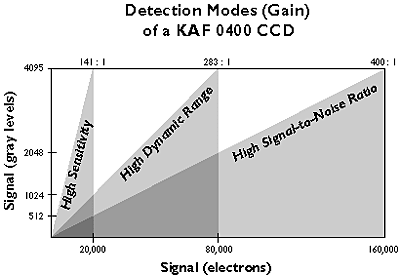Detection Modes
Many Teledyne Photometrics cameras operate in three distinct detection modes that are specifically designed to fully utilize the characteristics of the CCD. Before describing each mode it is useful to define a few terms:
| System Gain: | The number of photoelectrons per analog-to-digital unit (e-/ADU). |
| Single-Pixel Full Well Capacity: | The number of photoelectrons an individual pixel can contain before saturation. |
| Output Node: | A summing well just prior to the analog output of the CCD large enough to accommodate the combination of charge when binning. |
| Output-Node Full Well Capacity: | The number of photoelectrons the output node can contain before saturation. |
“HIGH SENSITIVITY” MODE
The system gain is set such that the entire 0 to 4095 analog-to-digital converter (ADC) range falls within the first 1/4 of the single-pixel full well capacity. The camera is most sensitive to light where only a slight change in light intensity registers as a change in an ADU. This mode is best suited for low-light applications.
“HIGH DYNAMIC RANGE” MODE
This mode sets the system gain such that the entire single-pixel full well capacity is realized. The ADC is adjusted to a point where an ADU value of 4095 is reached at the single-pixel full well capacity. This mode enables high-dynamic-range measurements (comparing both bright and dim features within the same image) at the full spatial resolution of the camera.
“HIGH SIGNAL-TO-NOISE RATIO” MODE
For a CCD camera, the maximum signal-to-noise ratio (SNRmax) is a function of the full well capacity of the sensor. Specifically, the SNRmax is equal to the square root of the full well capacity. Thus, the greater the full well capacity, the better the maximum SNR. Typically, the output-node full well capacity is much greater than that of a single pixel. When this mode is selected and a minimum of 2×2 binning is performed, the ADC is set to span the output-node full well capacity. The high SNR mode provides the highest precision when measuring small intensity changes on a bright background.

EXAMPLE:
For a CCD with the following characteristics:
Single-Pixel Full Well Capacity: 80,000 electrons
Output-Node Full Well Capacity: 160,000 electrons
The system gain would be as follows for each 12-bit detection mode:
High Sensitivity: 5 photoelectrons/ADU
Therefore, assuming a quantum efficiency of 40%, only 12 photons are required per pixel to toggle an ADU.
High Dynamic Range: 20 photoelectrons/ADU
The ADC spans the entire range of the single pixel, enabling intensity differences of up to 4096:1 to be measured within the same image while taking advantage of the CCD’s full spatial resolution.
High Signal-to-Noise Ratio: 40 photoelectrons/ADU
A signal that varies as little as 0.5% on a bright background can be detected with 96% confidence.
Each mode can be selected via software so that changes can be made during an experiment or pre-programmed for automated situations.
